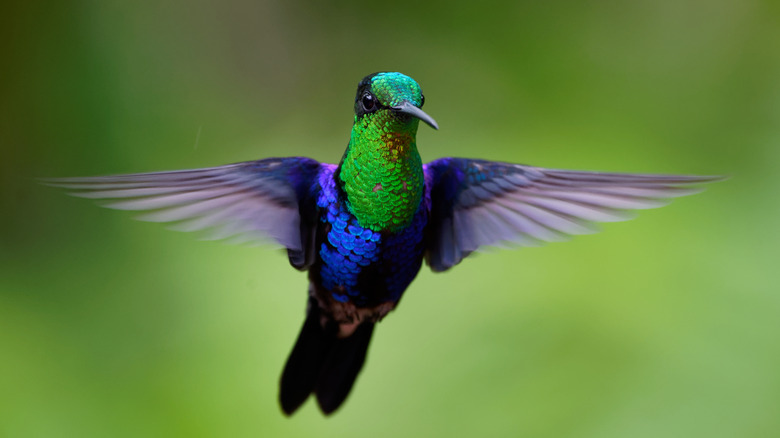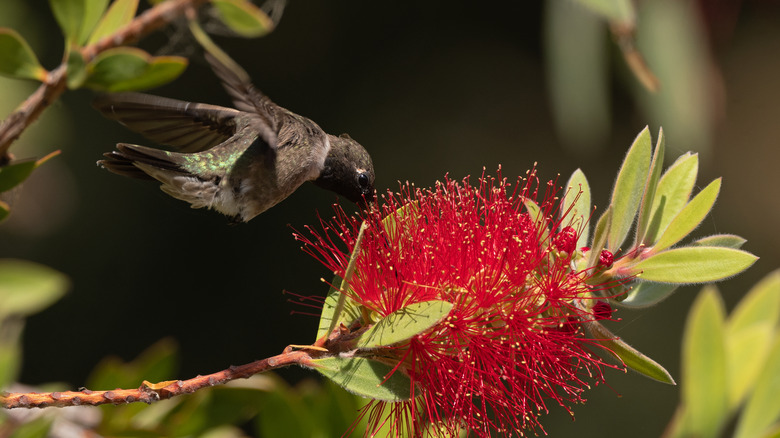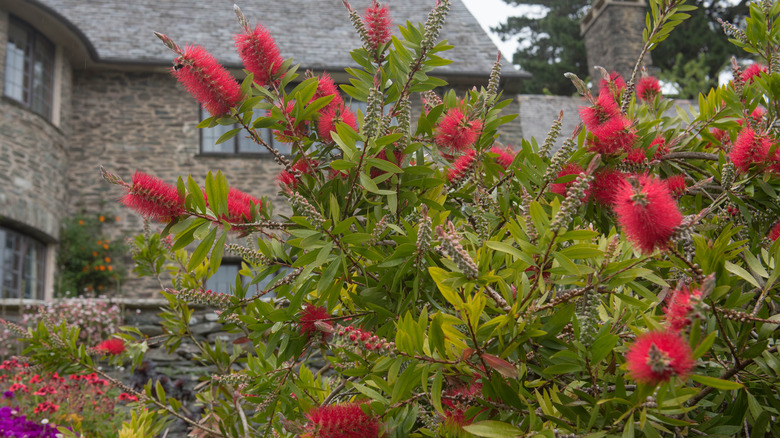The Flowering Plant That's A Garden Must For Hummingbird Lovers
Hummingbirds are sometimes considered the lone wolves of the avian world. Despite being migratory birds, they tend to not fly in flocks, and have the potential to travel up to 500 miles alone in just one trip. It's all quite impressive given their small size. And if you're hopeful a few of them will land in your yard while in flight, any wise bird-watcher will tell you that an important part of attracting hummingbirds is adding a few nectar plants to your yard. The pollinator friendly trees and shrubs provide a natural and reliable food source for hummingbirds and can give them protection from prey. And there's a particular plant that hummingbirds love to flock to: the beautiful and bold bottlebrush plant.
The bright-red flower spikes look like bottle-scrubbers and bloom for a significant part of the year from spring to summer, and sometimes all the way to fall. This plant can be grown as both a tree or a shrub and thrives in USDA Hardiness Zones 8b to 11b. As far as how to grow and care for a bottlebrush goes, keep in mind that it needs full sun and thrives in soil with a pH of 6.0 to 8.0, which covers the majority of garden soils. Given bottlebrush plants can tolerate salt in the air, they do particularly well in coastal regions, but they are also found in abundance in the South. The flowers will make the outside of your home look fabulous while attracting birds galore.
Provides nectar for hummingbirds
Because bottlebrush plants bloom right throughout the summer, and sometimes all the way into fall, they are an excellent and consistent food source for hummingbirds when other nectar plants are not in bloom. The bright-red bushy long stamens provide both nectar and pollen for hummingbirds to enjoy. Birds can smell the fragrant aroma of the flowers from far distances and the red flowers appeal to them because the color is a visual sign that food is nearby. Red is attractive to hummingbirds and appears brighter to them because of how they filter the color through their retina. Therefore, it is often a recommended hue to add to the garden to help attract hummingbirds.
Besides providing nectar, the plant attracts an abundance of tiny insects that hummingbirds like to feed on, too. Insects offer a source of protein for the small birds, which benefits their muscle and feather development. Usually, hummingbirds munch on them when sources of nectar have dried up, but in this case, they will have the option to feed on both! As a result, you can expect to see hummingbird species such as Anna's hummingbird, the ruby-throated hummingbird, and the glorious black-chinned hummingbird.
Offers shelter from predators
The leaves of the bottlebrush tree or shrub provide ideal shelter for hummingbirds to escape harsh weather and protect the bird from threats. The dense foliage gives them a safe space to perch and watch for predators such as snakes and even backyard cats. All this considered, it should be noted that hummingbirds are usually not backyard nesters. Even though they are attracted to certain shrubs, there's a smaller probability the females will choose to nest in your plant because they prefer more isolated wooded areas near water so they can easily weave together twigs, plant fibers, and leaves for their nests high in trees. But bird-watchers still have reported sightings of hummingbird nests in bottlebrush trees, so if your property conditions are right, you might just see one!
Nonetheless, bottlebrush trees and shrubs provide a habitat that hummingbirds need and will still bring more pollinators into your yard, even if they don't choose to nest there. One of the pollinator's greatest threats in the modern world is the loss of habitat due partly to climate change. So by planting a bottlebrush, you will be contributing to restoration efforts by expanding the natural environment hummingbirds thrive in. And your yard will have a little bit of character with the bushy red flowering plant at the same time.


